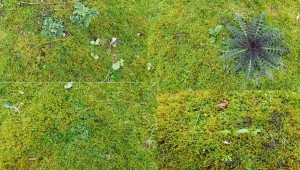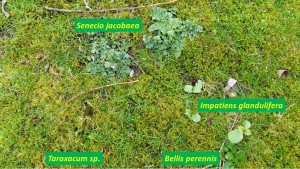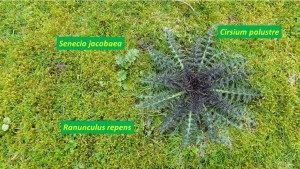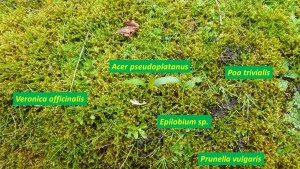Did you have a go at Dr M’s flowers in the moss botany quiz from his stop over in the Crewe Travelodge recently? If not try it out here and come back to check the answers below.
Between Dr M’s hotel and the stream was a mossy lawn with shed loads of Rhytidiadelphus squarrosus (Springy Turf Moss) but here and there were some other plants. This is the image from the quiz, it’s a composite of four separate images:
Here and there amongst the springy moss you can see some other plants, some quite small but others large enough to make out and these are labelled below in the four images (separated for clarity). Some of the smaller plants will take a bit of finding I should have put arrows on the images, but you can click on each image to see an enlarged version.
If you find any other species (there are some hiding in there for sure!) contact Dr M!
Top left:
Top right:
Bottom left:
Bottom right:
So the full list is fourteen species:
Acer pseudoplatanus (Sycamore seedling)
Bellis perennis (Daisy)
Cerastium fontanum (Common Mouse-ear)
Cirsium arvense (Creeping Thistle)
Cirsium palustre (Marsh Thistle)
Epilobium sp. (A Willowherb)
Impatiens glandulifera (Indian Balsam seedlings)
Poa trivialis (Rough Meadow-grass)
Prunella vulgaris (Selfheal)
Ranunculus repens (Creeping Buttercup)
Senecio jacobaea (Common Ragwort)
Taraxacum sect. Ruderalia (Common Dandelion)
Trifolium repens (White Clover)
Veronica officinalis (Heath Speedwell)
Dr M also asked: Which plant do you think will grow up soon and hide this woodland view?!
- Last years shoots on the ground
- Himalayan Balsam seedlings
Well for sure this is Indian Balsam! This non-native species is visible now only as seedlings amongst last years decaying stem remains. But give it a few weeks and surviving seedlings will grow upwards reaching 2 or even 3 metres tall!
Himalayan Balsam is also known as Policeman’s helmet owing to the attractive purplish-pink slipper-shaped flowers which appear in June. The flowers mature into explosive seed pods (much loved by children!) which explode when touched, scattering the seed up to 7m away. Seeds are also spread by water and they may remain viable for up to two years.
All in all this species is well adapted to spread in the riparian (water-side) environment and is classified as an invasive alien species and listed on Schedule 9 of the Wildlife and Countryside Act which means it is an offence to cause it to spread in the wild.
The Environment Agency and the Non Native Species Directorate is a good source of information on how to attempt control of this (essentially uncontrollable!) species.
Currently CABI – a science-based not-for-profit organization that specialises in agricultural and environmental research – are working on potential biological control of Himalayan Balsam using non native insect or plant pathogens (rust fungi), check the information here.
Finally a few images from the Environment Agency showing just how prolific (and beautifu!) this plant can be!











